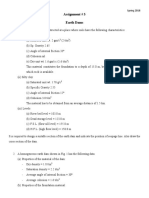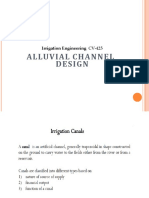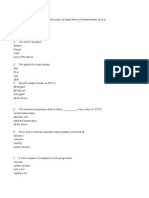Soil Compactation Problem Set
Soil Compactation Problem Set
Uploaded by
Archit SharmaCopyright:
Available Formats
Soil Compactation Problem Set
Soil Compactation Problem Set
Uploaded by
Archit SharmaOriginal Description:
Copyright
Available Formats
Share this document
Did you find this document useful?
Is this content inappropriate?
Copyright:
Available Formats
Soil Compactation Problem Set
Soil Compactation Problem Set
Uploaded by
Archit SharmaCopyright:
Available Formats
Assignment 1 (Compaction)
CE351A Soil Mechanics: Course instructor Arghya Das: Semester 1, 2016-17
1. The maximum dry unit weight and the optimum water content of a cohesive soil obtained from the
standard compaction test are 19.5kN/m3 and 12%, respectively. If the specific gravity of the soil solids is
2.70, what is the degree of the soil at its maximum dry unit weight? What is the maximum dry unit
weight it can be further compacted to?
2. Show the saturated moisture content is:
1
1
wsat = w
d s
3. The following observations were recorded when a sand cone test was conducted for finding the unitweight of a natural soil:
Total density of sand used in the test = 1.4 g/cm3
Mass of the soil excavated from hole = 950 g.
Mass of the sand filling the hole = 700 g.
Water content of the natural soil = 15%.
Specific gravity of the soil grains = 2.7
Calculate: (i) the wet unit weight; (ii) the dry unit weight; (iii) the void ratio; and (iv) the degree of
saturation.
4. A sample of soil compacted according to the standard Proctor test has a density of 2.06 g/cm3 at100%
compaction and at an optimum water content of 14%. What is the dry unit weight? What is the dry unit
weight at zero air-voids? If the voids become filled with water what would be the saturated unit weight?
Assume Gs = 2.67.
5. The maximum and minimum dry unit weights of a sand are 17.1 and 14.2 respectively. The sand in the
field has a relative density of 70% with a moisture content of 8%. Determine the moist unit weight of
the sand in the field.
6. During the construction of an embankment, the density attained by field compaction was investigated by
the sand jar method. A test pit was excavated in the newly compacted soil and was filled up by pouring
sand. The following were the observation :
Mass of soil excavated from pit = 2883 g
Mass of sand required to fill the pit = 2356 g
Bulk density of sand = 1.52 g/cc
Moisture content of embankment soil = 16%
Determine the dry density of the compacted soil.
7. An embankment was constructed by compacting a soil at a moisture content of 15.5% and a dry density
of 1.72 gm/cc. If the specific gravity of soil solids be 2.68, determine the void ratio and degree of
saturation of the embankment soil.
8. The test result of laboratory proctor test are shown below:
No of Test
1
2
3
4
5
6
Mass of mould and soil in kg
3.526 3.711 3.797 3.906 3.924 3. 882
Water content %
8.33 10.40 12.23 16.20 17. 92 20.39
The mould is 12.7 cm high and has an internal diameter of 10 cm. The mass of the empty mould is 1.89 kg.
a. Plot the moisture content vs dry density curve and determine the optimum moisture content and the
maximum dry density.
b. Plot the zero air void line curve and the 10% air void curve. Given G= 2.68
NOTE: Assume the necessary data if required.
You might also like
- Chapter 4 - Soil Compaction-1Document5 pagesChapter 4 - Soil Compaction-1Yandi TVNo ratings yet
- Consistency of SoilDocument31 pagesConsistency of SoilHatsuieeNo ratings yet
- Tutorial Chapter 2Document2 pagesTutorial Chapter 2wendyNo ratings yet
- Unit 4 Slope Stability AnalysisDocument15 pagesUnit 4 Slope Stability AnalysisJoshua John JulioNo ratings yet
- CE363 Old Homework Solutions Part2Document21 pagesCE363 Old Homework Solutions Part2mahavir damakaleNo ratings yet
- Calculation For Thermal Storage Tank DiffusersDocument2 pagesCalculation For Thermal Storage Tank DiffusersYamen SleimanNo ratings yet
- Dense Phase Co2 Transport PDFDocument87 pagesDense Phase Co2 Transport PDFSchöberl ErichNo ratings yet
- Geotech Practice-Problems CE2024Document7 pagesGeotech Practice-Problems CE2024Zina CabreraNo ratings yet
- Geotechnical Engineering 1 Problem #1Document4 pagesGeotechnical Engineering 1 Problem #1Muhammad BasitNo ratings yet
- A Sample of Wet Soil Has A Volume of 0Document8 pagesA Sample of Wet Soil Has A Volume of 0eph0% (1)
- Consolidation Settlement Examples 3 - Solutions (2) - 2Document6 pagesConsolidation Settlement Examples 3 - Solutions (2) - 2Sujani MaarasingheNo ratings yet
- Lecture2 - Vertical StressDocument123 pagesLecture2 - Vertical StressJoseph BaruhiyeNo ratings yet
- Chapter 5Document62 pagesChapter 5Mo Kops100% (1)
- Pile Problem 1Document3 pagesPile Problem 1ReemALMousawiNo ratings yet
- Example For Chapter - 2Document16 pagesExample For Chapter - 2sahle mamoNo ratings yet
- Lesson 8 ONE-DIMENSIONAL FLOW OF WATER THROUGH SOILSDocument24 pagesLesson 8 ONE-DIMENSIONAL FLOW OF WATER THROUGH SOILSNaruto UzumakiNo ratings yet
- 46C 1Document18 pages46C 1SHEKHARNo ratings yet
- Solved Problems in Soil Mechanics: SolutionDocument5 pagesSolved Problems in Soil Mechanics: SolutionMemo LyNo ratings yet
- Chapter 4Permeability-TE2 (Braja M. Das)Document50 pagesChapter 4Permeability-TE2 (Braja M. Das)Mohd Asis Latip100% (1)
- CH 2 Precipitation (Raghunath)Document30 pagesCH 2 Precipitation (Raghunath)Roel Briones100% (1)
- Solved Problems in Soil Mechanics: Ahmed S. Al-AghaDocument20 pagesSolved Problems in Soil Mechanics: Ahmed S. Al-AghaMemo LyNo ratings yet
- Soil Mechanics Solutions To Simple ProblemsDocument5 pagesSoil Mechanics Solutions To Simple ProblemsB Norbert100% (4)
- P&B m1Document5 pagesP&B m1Andrizal ChaidarNo ratings yet
- Irrigation Engineering Worksheet-One: A) Porosity (45.06%) ) )Document1 pageIrrigation Engineering Worksheet-One: A) Porosity (45.06%) ) )Reffisa Jiru100% (2)
- Geo Tech FormulasDocument5 pagesGeo Tech FormulasJoy KathleenNo ratings yet
- Module-43C: Sub: Geotechnical Engineering Topic: Three Phase SystemDocument169 pagesModule-43C: Sub: Geotechnical Engineering Topic: Three Phase Systemk govind goudNo ratings yet
- Irrigation EngineeringDocument18 pagesIrrigation EngineeringUmar NaveedNo ratings yet
- Mid Exam For Do StudentDocument2 pagesMid Exam For Do StudentLeulNo ratings yet
- Problems On Settlement in Foundation - PDFDocument46 pagesProblems On Settlement in Foundation - PDFNIKHIL BANDWALNo ratings yet
- MODULE 7 PermeabilityDocument11 pagesMODULE 7 PermeabilityJamaica Dela CruzNo ratings yet
- 2 HW II TGK - Chapter 2 Stresses in PavementsDocument68 pages2 HW II TGK - Chapter 2 Stresses in PavementsSemagn Mezgebu100% (1)
- One-Dimensional Flow of Water Through Soils: ImportanceDocument26 pagesOne-Dimensional Flow of Water Through Soils: ImportanceAngieNo ratings yet
- Hydrograph, Stream Gauging and Peak Flood Estimation: Unit 2Document93 pagesHydrograph, Stream Gauging and Peak Flood Estimation: Unit 2amitpatilnitkNo ratings yet
- Soil Mechanics 2Document3 pagesSoil Mechanics 2MarvinPatricioNarcaNo ratings yet
- 7 Shear Strength and Bearing Capacity in SoilDocument21 pages7 Shear Strength and Bearing Capacity in SoilJenina Logmao100% (1)
- Soil Mechanics (CE2251) Full Lecture NotesDocument127 pagesSoil Mechanics (CE2251) Full Lecture NotesRasulNo ratings yet
- CHAPTER 8C - SeepageDocument26 pagesCHAPTER 8C - SeepageTyn MaturanNo ratings yet
- Assignment # 3Document2 pagesAssignment # 3GEMPF100% (2)
- M2 03 Constant and Falling Head TestDocument13 pagesM2 03 Constant and Falling Head TestPzynae FlorentinoNo ratings yet
- Geothecnical Engg 2 - Characteristics of Soil 2012Document48 pagesGeothecnical Engg 2 - Characteristics of Soil 2012Renderizzah FloraldeNo ratings yet
- Basics For Rural ConstructionDocument83 pagesBasics For Rural ConstructionBernard Palmer100% (1)
- Alluvial Channel Design by Lacy and Kennedy TheoryDocument32 pagesAlluvial Channel Design by Lacy and Kennedy TheoryDaanial KhanNo ratings yet
- Effective Stress ConceptsDocument15 pagesEffective Stress ConceptsClairole Marie QuilantangNo ratings yet
- Notes Answers PDFDocument39 pagesNotes Answers PDFkbkwebs0% (1)
- Geo Problem Set 2Document27 pagesGeo Problem Set 2Marielle Jane B. TapangNo ratings yet
- Two Dimensional Flow of Water Through SoilDocument28 pagesTwo Dimensional Flow of Water Through SoilMinilik Tikur SewNo ratings yet
- Problem Set (GD)Document4 pagesProblem Set (GD)yadoleNo ratings yet
- Geotech1Lab-Laboratory Work No. 2 PDFDocument4 pagesGeotech1Lab-Laboratory Work No. 2 PDFMarc Carlo IbañezNo ratings yet
- Shallow Foundations - Examples 1Document2 pagesShallow Foundations - Examples 1Fatmah El WardagyNo ratings yet
- p&B-m2 Earth Pressure TheoDocument8 pagesp&B-m2 Earth Pressure TheoChetan PatilNo ratings yet
- Foundation Engineering: Module 2: Geotechnical Properties of SoilDocument4 pagesFoundation Engineering: Module 2: Geotechnical Properties of SoilAljon AvilaNo ratings yet
- CENG 197 Problem Set 2Document5 pagesCENG 197 Problem Set 2edmar limNo ratings yet
- CH 11 Compressibility of Soil4Document14 pagesCH 11 Compressibility of Soil4Boni ClydeNo ratings yet
- Experiment 6-Grain Size AnalysisDocument20 pagesExperiment 6-Grain Size Analysisaqib50% (2)
- Specific Gravity-ASTM D 854-14Document2 pagesSpecific Gravity-ASTM D 854-14Arslan MustafaNo ratings yet
- Problems in Flow NetDocument8 pagesProblems in Flow Netanumned100% (1)
- TR 323 Two-Lane HighwaysDocument36 pagesTR 323 Two-Lane HighwaysJames LaurentNo ratings yet
- Terzaghis Bearing CapacityDocument3 pagesTerzaghis Bearing CapacityDupio German IINo ratings yet
- Solved A Permeable Soil Layer Is Underlain by An Impervious La...Document1 pageSolved A Permeable Soil Layer Is Underlain by An Impervious La...Cristian A. GarridoNo ratings yet
- Problem For PracticeDocument7 pagesProblem For PracticeJayLord Mico PacisNo ratings yet
- The Chemistry of Soils - Including Information on Acidity, Nitrification, Lime Requirements and Many Other Aspects of Soil ChemistryFrom EverandThe Chemistry of Soils - Including Information on Acidity, Nitrification, Lime Requirements and Many Other Aspects of Soil ChemistryRating: 4 out of 5 stars4/5 (1)
- Soils as a Key Component of the Critical Zone 5: Degradation and RehabilitationFrom EverandSoils as a Key Component of the Critical Zone 5: Degradation and RehabilitationChristian ValentinNo ratings yet
- Open Elective Course Allotment List Even Semester 2013 14Document25 pagesOpen Elective Course Allotment List Even Semester 2013 14Archit SharmaNo ratings yet
- PHI447 Term PaperDocument9 pagesPHI447 Term PaperArchit SharmaNo ratings yet
- ADG Sugg PDFDocument2 pagesADG Sugg PDFArchit SharmaNo ratings yet
- Relativityproblems PDFDocument2 pagesRelativityproblems PDFArchit SharmaNo ratings yet
- ADG Fourierprobs2 PDFDocument5 pagesADG Fourierprobs2 PDFArchit SharmaNo ratings yet
- Domicile Category-B RPET-2012: Certificate - 1 (Ii)Document1 pageDomicile Category-B RPET-2012: Certificate - 1 (Ii)Archit SharmaNo ratings yet
- ADG Vibrations PDFDocument7 pagesADG Vibrations PDFArchit SharmaNo ratings yet
- California Bearing Ratio (CBR) Test PDFDocument20 pagesCalifornia Bearing Ratio (CBR) Test PDFEmil MemmedovNo ratings yet
- Fluidization PDFDocument26 pagesFluidization PDFU19CH081 Arnav GuptaNo ratings yet
- Astm D 1298Document6 pagesAstm D 1298Diego UgarteNo ratings yet
- As 1289.6.7.1-2001 Methods of Testing Soils For Engineering Purposes Soil Strength and Consolidation TestsDocument2 pagesAs 1289.6.7.1-2001 Methods of Testing Soils For Engineering Purposes Soil Strength and Consolidation TestsSAI Global - APACNo ratings yet
- Calculation of Air-Slide Conveyor: January 2017Document7 pagesCalculation of Air-Slide Conveyor: January 2017Hannan yusuf KhanNo ratings yet
- Ideal Solubility ParametersDocument14 pagesIdeal Solubility ParametersYuppie Raj100% (3)
- BRICK+SLUG PBDocument18 pagesBRICK+SLUG PBMateriales FicNo ratings yet
- Fluid Properties, Fluid Statics, Manometry, Buoyancy, Forces On Submerged Bodies, Stability of Floating Bodies Control-Volume Analysis of Mass.Document56 pagesFluid Properties, Fluid Statics, Manometry, Buoyancy, Forces On Submerged Bodies, Stability of Floating Bodies Control-Volume Analysis of Mass.Sahil GuptaNo ratings yet
- Preparation of Test Specimens of Asphalt-Stabilized Soils: Standard Practice ForDocument5 pagesPreparation of Test Specimens of Asphalt-Stabilized Soils: Standard Practice ForLuis LunaNo ratings yet
- STM 005 - Sas MergedDocument140 pagesSTM 005 - Sas MergedmidzyonceuNo ratings yet
- RATTI RAYDAN STEEMERS. Building Form and Environmental PerformanceDocument12 pagesRATTI RAYDAN STEEMERS. Building Form and Environmental PerformancebsceciliaNo ratings yet
- Fundamentals of Fluid MechanicsDocument77 pagesFundamentals of Fluid MechanicsvijaynieNo ratings yet
- Margolis, Emil - J. - Formulation and Stoichiometry PDFDocument230 pagesMargolis, Emil - J. - Formulation and Stoichiometry PDFOscar Perez RosalesNo ratings yet
- Some Basic Concepts Applied in ChemistryDocument7 pagesSome Basic Concepts Applied in ChemistryRidham GoyalNo ratings yet
- An Experiment of DensityDocument4 pagesAn Experiment of DensitySamuel TumewaNo ratings yet
- ASTM E 283-19 - Standard Test Method For Determining Rate of Air LeakageDocument7 pagesASTM E 283-19 - Standard Test Method For Determining Rate of Air LeakageDJ JMNo ratings yet
- Some Basic Relationships Between Density Values in Cancellous and Cortical BoneDocument8 pagesSome Basic Relationships Between Density Values in Cancellous and Cortical Boneloveyo9096No ratings yet
- Heat Transfer in Solids FinalDocument31 pagesHeat Transfer in Solids FinalMandrusca CatalinNo ratings yet
- Fluid Mechanics Objective Type QuestionsDocument223 pagesFluid Mechanics Objective Type Questionshello17No ratings yet
- Malzama PDFDocument63 pagesMalzama PDFAhmed100% (1)
- Polypipe Gdy20 Pe2406/Pe2708 Gas Pipe: Other Dimensional Standards or Custom Requirements AvailableDocument2 pagesPolypipe Gdy20 Pe2406/Pe2708 Gas Pipe: Other Dimensional Standards or Custom Requirements AvailableAdam KnottNo ratings yet
- Formula 6-AgDocument1 pageFormula 6-AgBernardo HoffmannNo ratings yet
- A Simplified Numerical Approach To The Evaluation of Residual Shaft Friction Induced by Concrete Curing in Drilled Shafts On Granular SoilsDocument15 pagesA Simplified Numerical Approach To The Evaluation of Residual Shaft Friction Induced by Concrete Curing in Drilled Shafts On Granular SoilsTen FreireNo ratings yet
- Tabel Konsolidasi (Version Terbaru)Document15 pagesTabel Konsolidasi (Version Terbaru)Andi Nuzulul Qadri BaktiNo ratings yet
- BulkDocument8 pagesBulkYul100% (1)
- Labrep Experiment 6 - ViscosityDocument5 pagesLabrep Experiment 6 - ViscosityArianne BatallonesNo ratings yet
- Process DesignDocument46 pagesProcess Designdevya123No ratings yet
- Sample Fans and Blowers Problems #1Document8 pagesSample Fans and Blowers Problems #1DEKUU MidoriyaNo ratings yet
































































































